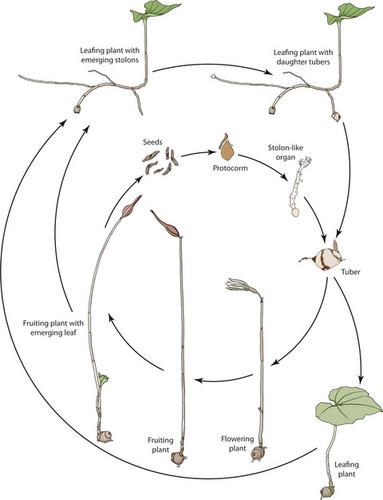Our official English website, www.x-mol.net, welcomes your feedback! (Note: you will need to create a separate account there.)
International Biological Flora: Nervilia nipponica
Journal of Ecology ( IF 5.5 ) Pub Date : 2021-05-06 , DOI: 10.1111/1365-2745.13683 Stephan W. Gale 1 , Ayako Maeda 2 , Ayana Miyashita 3 , Daisuke Sugiura 4 , Yuki Ogura‐Tsujita 5 , Akihiko Kinoshita 6 , Shohei Fujimori 2 , Michael J. Hutchings 7 , Tomohisa Yukawa 8
中文翻译:

国际生物区系:Nervilia nipponica
更新日期:2021-07-09
Journal of Ecology ( IF 5.5 ) Pub Date : 2021-05-06 , DOI: 10.1111/1365-2745.13683 Stephan W. Gale 1 , Ayako Maeda 2 , Ayana Miyashita 3 , Daisuke Sugiura 4 , Yuki Ogura‐Tsujita 5 , Akihiko Kinoshita 6 , Shohei Fujimori 2 , Michael J. Hutchings 7 , Tomohisa Yukawa 8
Affiliation

|
- This account presents information on all aspects of the biology of Nervilia nipponica Makino (mukago-saishin) that are relevant to understanding its ecological characteristics and behaviour. The main topics are presented within the standard framework of the International Biological Flora: distribution, habitat, communities, responses to biotic factors, responses to the environment, structure and physiology, phenology, floral and seed characters, herbivores and disease, history, conservation and global heterogeneity.
- Nervilia nipponica is a small, stoloniferous, seasonally dormant herb that grows in the understorey of evergreen forests in the humid subtropical zone of central and western Japan, with a few outlying populations on Jeju Island in South Korea. Its northern extent is defined by the 0°C winter isotherm, and its occurrence is also limited by site aspect and incline. It is a weak competitor that occupies species-poor microsites in which bare ground and leaf litter predominate. Plant numbers tend to decline as percentage ground cover of surrounding understorey vegetation increases.
- The inflorescence sprouts from a short-lived, subterranean tuber in late spring and leaf-flush occurs after fruit-set. However, most tubers do not flower in any one annual growth cycle. Long-term monitoring of individually marked plants suggests that tubers are resource-limited and that flowering constrains future genet growth. Nervilia nipponica is exclusively autogamous and has a strong capacity for vegetative propagation. The species is genetically depauperate but exhibits significant differentiation between populations, which comprise clonal clusters in phalanx formation.
- The level of mycorrhizal infection differs between plant parts and through successive phenological stages. Stable isotope signatures indicate that the species is partially mycoheterotrophic, with fungal partners supporting growth particularly at lower light intensities. Despite this, falling light availability associated with forest succession can lead to population decline.
- Populations tend to be small and prone to extirpation, but the species is probably under-recorded as a result of its ephemeral emergence above-ground and inconspicuous habit. Management interventions likely to benefit the species at the site level include thinning dense forest canopy and removing encroaching ground cover.
中文翻译:

国际生物区系:Nervilia nipponica
- 该帐户提供了有关Nervilia nipponica Makino ( mukago-saishin )生物学的所有方面的信息,这些信息与了解其生态特征和行为有关。主要议题在国际生物植物群的标准框架内提出:分布、栖息地、群落、对生物因素的反应、对环境的反应、结构和生理学、物候学、花卉和种子特征、食草动物和疾病、历史、保护和全球异质性。
- Nervilia nipponica是一种小的、有匍匐茎的、季节性休眠的草本植物,生长在日本中西部潮湿的亚热带地区的常绿林下层,在韩国济州岛有一些外围种群。其北部范围由 0°C 冬季等温线定义,其发生也受场地方位和倾斜度的限制。它是一个弱的竞争者,它占据了以裸地和落叶为主的物种贫乏的微型场所。随着周围下层植被的地面覆盖百分比增加,植物数量趋于下降。
- 花序在晚春从短命的地下块茎中发芽,坐果后出现同花叶。然而,大多数块茎不会在任何一年的生长周期中开花。对单独标记植物的长期监测表明,块茎资源有限,开花限制了未来的基因生长。Nervilia nipponica是完全自交的,具有很强的营养繁殖能力。该物种在遗传上是衰老的,但在种群之间表现出显着的分化,其中包括方阵形成中的克隆簇。
- 菌根感染的水平在植物部分之间和通过连续的物候阶段不同。稳定的同位素特征表明该物种是部分真菌异养的,真菌伙伴支持生长,尤其是在较低的光照强度下。尽管如此,与森林演替相关的光照减少会导致人口下降。
- 种群往往很小且容易灭绝,但由于其短暂出现在地上且习性不显眼,因此该物种可能被低估了。可能在现场一级使该物种受益的管理干预措施包括疏伐茂密的森林树冠和移除被侵占的地面覆盖物。



























 京公网安备 11010802027423号
京公网安备 11010802027423号